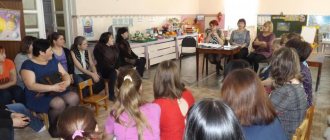Summary of the parent meeting on the topic “Children’s safety on the road”
Author: Kruglikova Olga Stepanovna
Summary of the parent meeting in the preparatory group
Parent meeting in the preparatory group on the topic “Children’s safety on the road.”
Author: Olga Stepanovna Kruglikova, teacher at MBDOU No. 90, Kemerovo.
Target:
Pedagogical education and involvement of parents in the process of teaching preschoolers the skills of safe behavior on the roads and streets of the city, developing a sense of responsibility for the life and health of their children.
Tasks:
— Familiarize parents with the theoretical foundations of road safety. — To create motivation in parents to self-develop a culture of safe behavior for children on the streets and roads. — Create conditions for interaction with society to prevent road traffic injuries among preschool children.
Parent meeting agenda:
1. Opening remarks. 2. Message from the group teacher. 3. Recommendations for parents on teaching children traffic rules.
4. Distributing a handout for parents “What can I do?”
Progress of the parent meeting:
1. Opening speech by the teacher:
“Our children were born to live joyfully. To play together, to be strong friends, to give smiles to each other and flowers, so that dreams always come true in their lives.”
Yes, our children are born precisely for this, but whether this always happens, whether life will be overshadowed by tragedy - this largely depends on us, adults. The topic of today's meeting is “Children's safety on the road.” The need for a meeting on traffic rules is dictated by life itself. The terrible statistics of child mortality and health damage as a result of road accidents are simply terrifying. And most often we, the adults, are to blame for tragedies. At this meeting we will talk about what parents can do to keep their child safe on the road. First of all, parents should understand that this task of protecting their child on the road is fundamentally unsolvable. Firstly, any movement by transport (and even on your own feet) is associated with danger, and the probability of the unexpected happening is always different from zero. This was not said at all to scare parents, but on the contrary, to draw their attention to the fact that you should always take care of the children’s safety (and your own). Secondly, the task of protecting the child once and for all cannot be solved, because the child is growing, and the possible dangers that await him on the road are growing. Therefore, children should be promptly taught the ability to navigate a traffic situation, cultivate the need to be disciplined on the street, careful and prudent. And parents should not make the most common mistake - acting on the principle “you can do it with me.” If you show your child by your own example how to run to red, be sure that when left alone, he will try to repeat this trick. Dear parents! Remember, if you break the Rules, your child will do the same! We have the power to develop the skills of safe behavior on the roads, to educate a conscious and competent pedestrian, responsible for the life and health of road users.
2. Message from the group teacher.
Today's children have to live with incomparably more aggressive traffic, and therefore every day it is becoming more and more difficult to ensure their safety. It is very important from preschool age to develop in children the skills of safe behavior on the road and to raise law-abiding citizens. Our task is to develop in children an understanding of the dangers that the automotive world conceals. It is important to do this before the child adopts and accepts the wrong stereotypes of behavior on the road, which, unfortunately, are currently prevalent in the adult environment. The study of traffic rules in kindergarten takes place in special classes, during games (didactic, active, role-playing), entertainment, etc. The topic of traffic rules covers not only educational, but also other types of classes - mathematics, familiarization with fiction, arts and crafts, physical education, etc. In classes, children learn to navigate in space, simulate various situations on the road, and play them out. We also form motor skills in children: children must not only move correctly in accordance with the received signal or, focusing on an adult, but also be able to coordinate their movements with the movement of other people and the movement of objects. In addition, with the help of didactic games we try to develop voluntary, active attention, because For safe behavior on the streets, it is necessary to develop in children voluntary attention and the ability to concentrate on the road situation. Preschool children are a special category of pedestrians and passengers. They cannot be approached with the same standards as adults, so there is a need to create a certain system to familiarize children with traffic rules and instill in them the skills of safe behavior on the roads and streets of various settlements. It is safe to say that work in this area is being carried out quite effectively, since for several years now no violations or accidents involving pupils of our kindergarten have been recorded. Our goal is not only to give children knowledge about the rules of the road, but also to develop in them the skills to adequately apply this knowledge in various situations, so that these skills develop into a habit.
3. Recommendations for parents on teaching children traffic rules.
Let me remind you once again of the basic rules that a child should know:
1. Basic terms and concepts of the rules. 2. Responsibilities of pedestrians. 3. Responsibilities of passengers. 4. Traffic regulation. 5. Traffic lights. 6. Warning signals. 7. Traffic across railway tracks. 8. Traffic in residential areas and transportation of people. 9. Features of cycling.
Remember! The child learns the laws of the roads, following the example of family members and other adults. Don't waste time teaching your children how to behave on the road. To prevent your child from creating a dangerous situation on the roads, he must be able to: • watch the road; • correctly assess the road situation in all its variability; • see, listen, anticipate, avoid danger.
Watch the road.
1. It is necessary to teach children not only to follow the traffic rules, but also from a very early age to teach them to observe and navigate. It must be taken into account that the main way to develop behavioral skills is through observation and imitation of adults, especially parents. 2. When you are on the roadway with your child, do not rush, cross the road at a measured pace. Otherwise, you will learn to rush where you need to watch and ensure safety. 3. Teach your child to notice a car. Sometimes a child does not notice a car from afar. Teach him to peer into the distance. 4. Teach your child to estimate the speed and direction of the future movement of the car. Teach your child to determine which one is going straight and which one is preparing to turn. 5. Teach your child to watch. The habit of inspecting the street in both directions should be brought to automaticity before taking the first step from the sidewalk to the roadway. You need to look especially carefully at the street when there is a family home or acquaintance on the opposite side, or when a child crosses the street with other children - it is in these cases that it is easy to miss the car.
Correctly assess the road situation.
The main danger is a stationary car. Why? Yes, because having seen the approaching car in advance, the pedestrian will give way to it. A stationary car deceives: it can block a moving one, preventing you from noticing the danger in time.
Rule #1.
You cannot go out onto the road because of parked cars. As a last resort, you need to carefully look out from behind a standing car, make sure that there is no danger, and only then cross the street. Watch with your child the cars standing at the edge of the roadway and pay attention to the moment when another one suddenly appears from behind the standing car. Draw your child's attention to the fact that a bus standing at a stop also makes it difficult to see the car moving behind it.
Rule #2
You need a parked bus neither in front nor behind! A standing bus, no matter how you go around it - in front or behind, covers a section of the road along which a car can pass at the moment when you decide to cross it. In addition, people near the bus stop are usually in a hurry and forget about safety. We have to wait until the bus leaves.
Rule #3
And at the traffic lights you can meet danger! Children often reason like this: “The cars are still standing, the drivers see me and will let me through.” They are wrong. Immediately after turning on the green signal for drivers, a car that was not visible behind the standing cars and whose driver cannot see the pedestrian may enter the crossing. If the green traffic light for pedestrians goes out, you need to stop. The child must not only wait for the right light, but also make sure that all the cars have stopped.
Rule #4
Develop in your child the habit of always stopping, looking around, listening before going out on the road, even if there are no cars on it, and only then cross the street.
Rule #5
Strong transport behavior skills in children are formed only through daily systematic training! During every walk with children, trips with them on business, to visit, out of town, etc. teach them to observe the street and transport, analyze the road situations encountered, see dangerous elements in them, and act accurately in various circumstances.
Rule #6
There is no need to instill in children an excessive sense of fear of traffic and moving cars. Let everything that is connected with kindergarten (and later school), including the road, be associated with the bright and kind in the child. At the same time, you need to teach him to be attentive, and this is not an easy thing. The processes of perception, attention and reaction in a child and an adult are completely different. Experienced drivers know, for example, that sounding the horn when they see a child running across the road is dangerous. The child may act unpredictably - instead of stopping, he may rush without looking back under the wheels of another car. Even those children who know the rules of the road sometimes break them. Don't take the trouble to help the children. You may have to stop a child who doesn't want to wait for a traffic light. Do it kindly.
4. Distribute reminders for parents “What can I do?”
Memo “What can I do?” (Appendix No. 1) will tell you what parents can do to keep their child safe on the road.
So, if you teach your children to follow these basic rules of behavior on the roads, then trouble will not come to your home.
In conclusion, it is worth noting that studying traffic rules is just as necessary as studying basic subjects (mathematics, Russian language). After all, the safety of our children’s lives is no less important than the indicator of their intellectual development, and even much more significant. When teaching a child the rules of the road, an adult must clearly understand what needs to be taught and how to do it more effectively. He himself must be well versed in road situations. Therefore, you should not only analyze your life experience in advance, but also study the necessary literature on the topic “Road Rules”. What and, most importantly, how well we teach a child, what skills of safe behavior on the street we instill in him, will protect him all his life. Attached files: comments powered by HyperComments
Parent meeting on traffic rules in the middle group of kindergarten “Traffic rules are worthy of respect!”
Parent meeting on traffic rules in the middle group of kindergarten “Traffic rules are worthy of respect!”
Goal: Generalize the knowledge of parents about teaching their children safe behavior skills on the streets.
Tasks:
Encourage parents to think that compliance with traffic rules is the most important thing for preserving the life and health of their children. Familiarize parents with some rules and reminders that contribute to the most effective traffic rules. Introduce parents to methods of teaching children traffic rules.
Progress of the meeting:
I. Hello, dear parents! On modern streets, the number of cars is increasing every day, and accordingly, the number of accidents is increasing. Therefore, today the question of the rules for the safe behavior of children on the road and in transport has become even more relevant and acute.
The most precious thing a person has in the world is our children. And today we will talk about how we, adults, should form children’s knowledge about the rules of the road. The main thing that children must remember and understand is that under no circumstances should they go for a walk without adults. The child needs to be told in his own words about the rules of the road and only to the extent that he is able to learn.
Walking down the street with a child, you need to talk to him about the types of vehicles that are nearby at that moment, explain their features. When crossing the street, you need to mention how and where you can cross the roadway correctly, remember how and where you cannot do this. During the learning process, it is very important not to frighten the child with the street and transport. After all, such fear is just as dangerous for him as carelessness or inattention. On the contrary, it is necessary to develop in him attention, composure, responsibility, confidence and caution. The child must learn to navigate in space, understanding concepts such as close, far, left, right, behind, in the direction of travel; it is also necessary to correctly perceive the speed of movement of both vehicles and pedestrians: fast, slow, turning, stopping. A very effective method of teaching children traffic rules is also to read them poems, riddles, and children's books dedicated to traffic safety. It is very important to remember that the greatest influence on the formation of a child’s behavior on the street is the corresponding behavior of adults. You need to show him by example how to behave correctly on the street.
II. Analysis of traffic situations. Analysis.
On the tables you have cards describing road situations. What do you think should be done in this or that case?
- A mother walks with her son from kindergarten along the sidewalk. The boy runs in front of her, anywhere and interferes with pedestrians. Mom doesn't react to this.
Question. What should a mother do? (Answer: The mother should react to her son’s behavior, explain to the child that he should walk along the sidewalk with her hand, not run in front, and not interfere with other pedestrians.)
- Mom and son walk down the street. On the opposite side, the boy sees his dad and rushes across the road to him.
Question. What should mom have done?
(The mother should hold the child tightly by the hand. The habit of looking around the street in both directions should be brought to automaticity before taking the first step from the sidewalk onto the roadway. You need to look especially carefully at the street when your home, friends, or when your child is on the opposite side crosses the street with other children - it is in these cases that it is easy not to notice the car. Do not rush or run towards them, instill in the child that this is dangerous).
- Mom walks with her son down the street. There is a crowd of people around the stall. The mother lets go of the child’s hand and approaches the stall.
Question. What should mom have done? (Under no circumstances let go of the child’s hand. Explain to him the rules of behavior in public places).
- A father walks with his child along the sidewalk. The child has a ball in his hand. The ball falls on the road. The child runs after him.
Question. What should dad do? (the child must be held tightly by the hand; you must not give the child a ball when moving along the sidewalk or crossing the road)
- Dad picks up his son from kindergarten. The child walks to the front door and sits in the passenger seat.
Question: Is this correct? (dad must place the child in the back seat in a child car seat and fasten the seat belt)
III. Working with the memo
— And now I want to give you “Memos” that will help you continue your work on enforcing traffic rules. Read them carefully and be guided by them in life.
Memo for parents.
Take your time, cross the road at a measured pace. When going out onto the road, stop talking - the child must get used to the fact that when crossing the road you need to concentrate.
Do not cross the road at a red or yellow traffic light, no matter how much you are in a hurry. Cross the road only in places marked with the “Pedestrian Crossing” road sign.
Get off the bus, trolleybus, tram, taxi first. Otherwise, the child may fall or run onto the roadway.
Invite your child to participate in your observations of the situation on the road, show him those cars that are preparing to turn, driving at high speed, etc.
Do not leave with your child from behind bushes or a car without first checking the road - this is a typical mistake and children should not be allowed to repeat it.
Do not allow play near the road or on the carriageway.
V. Summary. The law of streets and roads, called “Road Rules,” is strict. He does not forgive if a pedestrian walks down the street as he pleases, without following the rules. But the law is at the same time very kind: it protects people from terrible misfortune, protects their lives. Today you showed good knowledge of the rules that help you on the road. And we sincerely hope that you will teach these rules to your children.
We are glad that you came to our parent meeting and took an active part in the game. I wish you never to break traffic rules!
Get text




